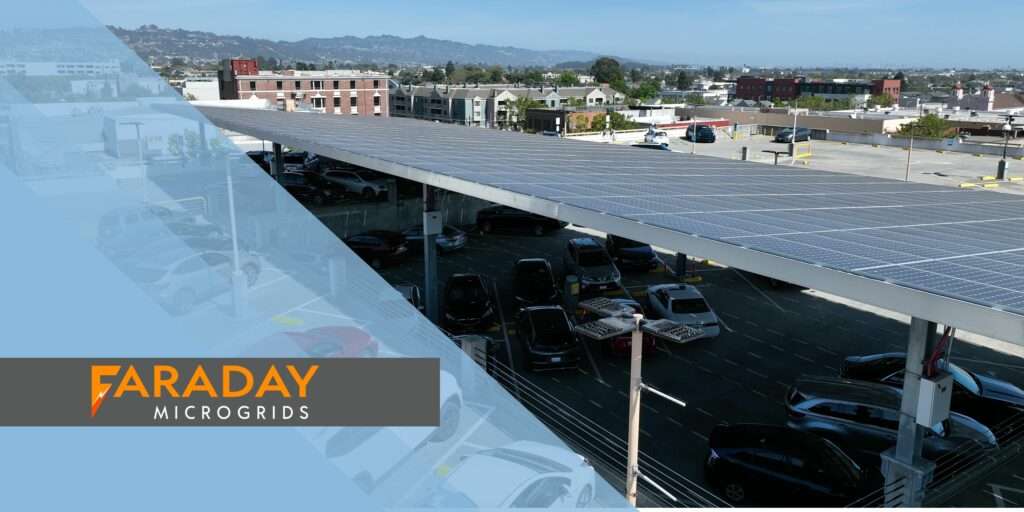What Is a Microgrid?
A microgrid is a combination of local energy resources that are coordinated to serve a building or campus and, as needed, maintain electrical services when the main electrical grid goes down.
A Microgrid operates as a self-regulating energy system that optimizes power availability, financial performance, and sustainability.
What Are the Benefits of a Microgrid?
Microgrids yield at least three significant value streams for all parties:
- Return on Investment – Significant utility cost savings, tax, cash and other incentives
- Resiliency – Continuity of operations despite utility outages
- Renewability – Signaling sustainability through clean energy

How Do Microgrids Achieve ROI?
Microgrids autonomously manage local energy production, optimization of its time-of-use, reduction of utility energy and demand fees, and can even capture new revenues such as Automated Demand Response (ADR) payments.
Studies have shown that peak energy demand charges can be as much as 70% of total monthly charges, depending on a facility’s power needs. A microgrid can be programmed to take over energy dispensation during heavy usage periods, or ‘peaks’, allowing a facility to drive down its utility spend by shifting the usage of stored energy to the highest cost periods. This converts painful OPEX into usable capital available for other, more valuable purposes.
Imagine a college campus that pays millions annually in utility costs, including significant demand fees. The institution has done all it can to maximize energy efficiency, but needs to find ways to further slash OPEX. A renewable energy microgrid, including solar, wind, or fuel cell generation, battery energy storage systems, and the appropriate autonomous controls fills this gap with reduction or even near elimination of utility expense for the long term. When peak demand and energy cost times roll around—heating/cooling and other high-intensity equipment —the microgrid releases the stored energy, rather than drawing from the grid. This squeezes every dollar of value out of the energy resources and stops the financial “bleeding.”
What is Resiliency and Why Does it Matter:
With increasingly threatening events such as fire, floods, winds, earthquakes, and heat/cold emergencies, the utility energy grid is showing increasing vulnerability. Prolonged outages not only threaten building operations, productivity, and revenue, but can even lead to damage to critical systems and occupants. Gulf Coast hurricanes, California fires, and Texas freezes have all demonstrated the significant impacts that these outages can have. For facilities that serve the health and safety of people, outages can be devastating.
Properly configured microgrids target these problems with the ability to “island.” In simple terms: if there is a disruption of the main energy grid, a microgrid can still provide power to the building, campus, or community and maintain essential operations for hours, days, or even longer.
What Makes a Microgrid “Renewable” or “Sustainable”?
Stakeholders are increasingly concerned about the commercial and public entities they utilize demonstrating social and environmental responsibility. They are looking for organizations that Reduce, Reuse, Recycle, and minimize their environmental footprint – particularly as it pertains to energy generation and utilization.
Renewable Energy Microgrids include clean generation technologies – solar, wind, geothermal, hydrogen, and others – to Reduce consumption of dirty central grid generation and visibly signal this commitment to critical stakeholders. Institutions that incorporate renewable energy microgrids will increase stakeholder loyalty, experience positive social media exposure, and avoid the increasingly harmful scorn being faced by entities that are not getting onboard with Sustainability.
Who Needs a Microgrid?
Microgrids have the most profound benefits for communities and businesses that want to slash costs, increase their energy security and resilience, as well as reduce their environmental impact.
Microgrids are most impactful on:
- Hospitals and other healthcare facilities
- Manufacturing and Industrial Businesses
- Critical technology facilities such as data centers
- Colleges and Universities
- Food Processors
- Grid-Edge or Remote Areas
- Tribal Communities
Each of these types of locations or facilities share the common needs to cut costs, improve resiliency, and become renewable. While each may prioritize these features differently, microgrids serve whichever prioritization schema is best for the site.
At the end of the day, virtually all major consumers of utility energy can achieve mission-critical goals through renewable energy microgrids.
Where Can I Source a Microgrid?
Since 2011, the experts at Faraday Microgrids have developed, designed, built, and operated renewable energy microgrids by combining tailored solutions to optimize site performance. They have pioneered systems in some of the most difficult and regulated environments (Hospitals) and can bring this expertise to virtually any commercial facility.
Learn more and get your FREE facility analysis HERE.


